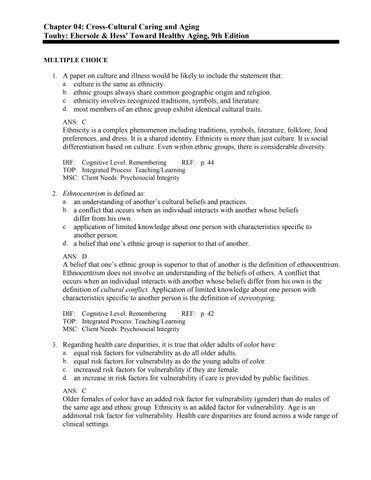Chapter 04: Cross-Cultural Caring and Aging Touhy: Ebersole & Hess' Toward Healthy Aging, 9th Edition MULTIPLE CHOICE 1. A paper on culture and illness would be likely to include the statement that: a. culture is the same as ethnicity. b. ethnic groups always share common geographic origin and religion. c. ethnicity involves recognized traditions, symbols, and literature. d. most members of an ethnic group exhibit identical cultural traits. ANS: C
Ethnicity is a complex phenomenon including traditions, symbols, literature, folklore, food preferences, and dress. It is a shared identity. Ethnicity is more than just culture. It is social differentiation based on culture. Even within ethnic groups, there is considerable diversity. DIF: Cognitive Level: Remembering REF: p. 44 TOP: Integrated Process: Teaching/Learning MSC: Client Needs: Psychosocial Integrity 2. Ethnocentrism is defined as: a. an understanding of another’s cultural beliefs and practices. b. a conflict that occurs when an individual interacts with another whose beliefs
differ from his own. c. application of limited knowledge about one person with characteristics specific to
another person. d. a belief that one’s ethnic group is superior to that of another. ANS: D
A belief that one’s ethnic group is superior to that of another is the definition of ethnocentrism. Ethnocentrism does not involve an understanding of the beliefs of others. A conflict that occurs when an individual interacts with another whose beliefs differ from his own is the definition of cultural conflict. Application of limited knowledge about one person with characteristics specific to another person is the definition of stereotyping. DIF: Cognitive Level: Remembering REF: p. 42 TOP: Integrated Process: Teaching/Learning MSC: Client Needs: Psychosocial Integrity 3. Regarding health care disparities, it is true that older adults of color have: a. equal risk factors for vulnerability as do all older adults. b. equal risk factors for vulnerability as do the young adults of color. c. increased risk factors for vulnerability if they are female. d. an increase in risk factors for vulnerability if care is provided by public facilities. ANS: C
Older females of color have an added risk factor for vulnerability (gender) than do males of the same age and ethnic group. Ethnicity is an added factor for vulnerability. Age is an additional risk factor for vulnerability. Health care disparities are found across a wide range of clinical settings.

